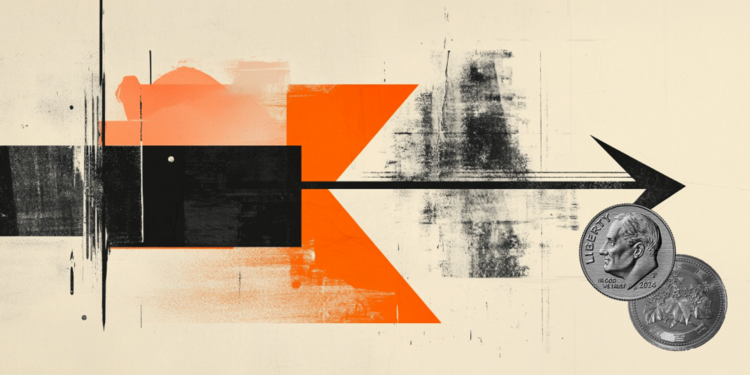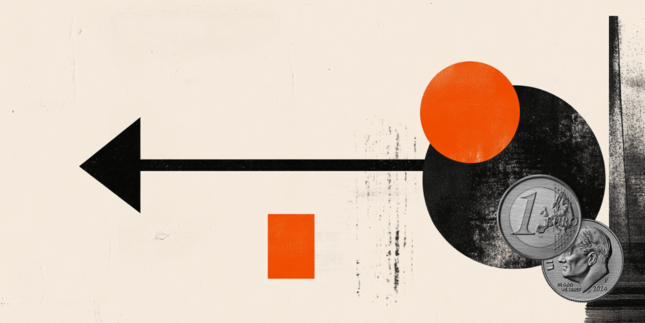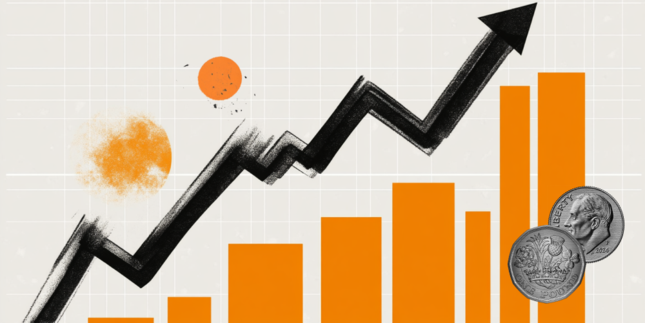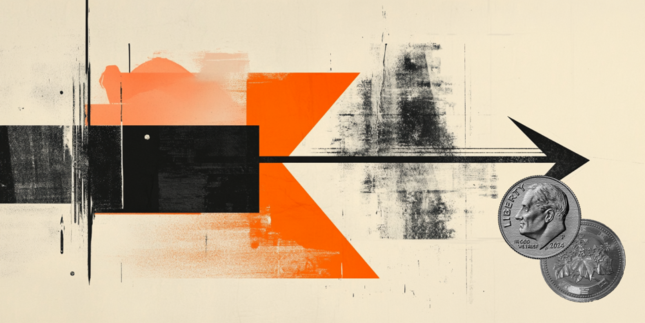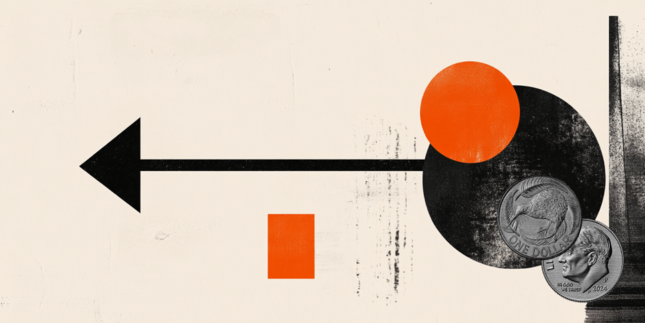Japanese Yen remains on the defensive amid positive risk tone; BoJ in focus
- The Japanese Yen lacks any firm intraday direction on Wednesday amid mixed fundamental cues.
- A positive risk tone and disappointing Japanese macro data cap the upside for the safe-haven JPY.
- Expectations for additional BoJ rate hikes in 2025 should continue to support the JPY and limit losses.
The Japanese Yen (JPY) remains on the defensive against its American counterpart for the second straight day on Wednesday in the wake of receding safe-haven demand and disappointing domestic data. The global risk sentiment remains supported by the optimism led by signs of easing US-China trade tensions and US President Donald Trump's decision to give flexibility on tariffs to US carmakers. The JPY bears, however, seem reluctant to place aggressive bets and opt to wait for the crucial Bank of Japan (BoJ) policy decision on Thursday.
The Japanese central bank is widely expected to keep interest rates steady amid heightening risks to the fragile economy from US tariffs. However, signs of broadening inflation in Japan keep the door open for further BoJ policy normalization. Moreover, persistent geopolitical tensions and concerns about Trump's erratic trade policies keep investors on the edge. Heading into the key central bank event risk, the fundamental backdrop warrants some caution before placing aggressive JPY bearish bets and positioning for any meaningful depreciation.
Japanese Yen is undermined by signs of easing trade tensions as traders await BoJ decision on Thursday
- US President Donald Trump signed an order that will allow US carmakers to reduce the amount they pay in import taxes on foreign parts. Moreover, White House officials said that parts made in Canada and Mexico that follow North American free trade rules would not face tariffs.
- This comes on top of progress on trade negotiations and hopes for further trade deals, which remains supportive of a positive risk tone. In fact, US Treasury Secretary Scott Bessent said earlier this week that many top US trading partners have made "very good" tariff proposals.
- Government data released earlier this Wednesday showed that Japan's Industrial Production shrank 1.1% in March, much more than expected. Adding to this, Japan's Retail Sales also fell short of estimates and grew 3.1% YoY in March, acting as a headwind for the Japanese Yen.
- The Bank of Japan kickstarts its policy meeting today and will announce its decision on Thursday. The central bank is expected to move cautiously and pause further interest rate hikes amid growing concerns that the new US tariffs could sharply slow Japan's economic growth.
- Expectations beyond the April meeting are divided amid mixed economic signals from Japan. However, persistent inflationary pressures and bumper pay hikes offered by big firms this year give the BoJ headroom to continue tightening its monetary policy this year.
- In contrast, the disappointing US Job Openings and Labor Turnover Survey (JOLTS) and the US Conference Board’s Consumer Confidence Index released on Tuesday strengthened the case for the resumption of the Federal Reserve's rate-cutting cycle in the coming months.
- In fact, the US Bureau of Labor Statistics (BLS) reported that US job openings dropped sharply, to 7.19 million by the last day of March from the 7.480 million (revised from 7.56 million) open positions reported in the previous month. This reading was below expectations of 7.5 million.
- Adding to this, the US Consumer Confidence Index slumped to 86.0 in April, or a nearly five-year low, amid concerns over the potential economic fallout from Trump's tariffs. Furthermore, the Present Situation Index and the Expectations Index fell to 133.5 and 54.4, respectively.
- CME FedWatch Tool puts the odds of a 25 bps Fed rate cut in June at 65%. Traders are also pricing in up to 100 bps in cuts by year-end, a key factor keeping the US Dollar near multi-year lows.
- Traders now look to Wednesday's key US data – the ADP report on private-sector employment, the Advance Q1 GDP, and the Personal Consumption and Expenditure (PCE) Price Index. Adding to this the US Nonfarm Payrolls report on Friday may provide insight into the Fed's policy outlook.
- In the meantime, the divergent BoJ-Fed policy expectations should continue to act as a tailwind for the lower-yielding JPY and cap the upside for the USD/JPY pair.
USD/JPY bears have the upper hand while below the 144.00 mark, or the 100-period SMA on H4
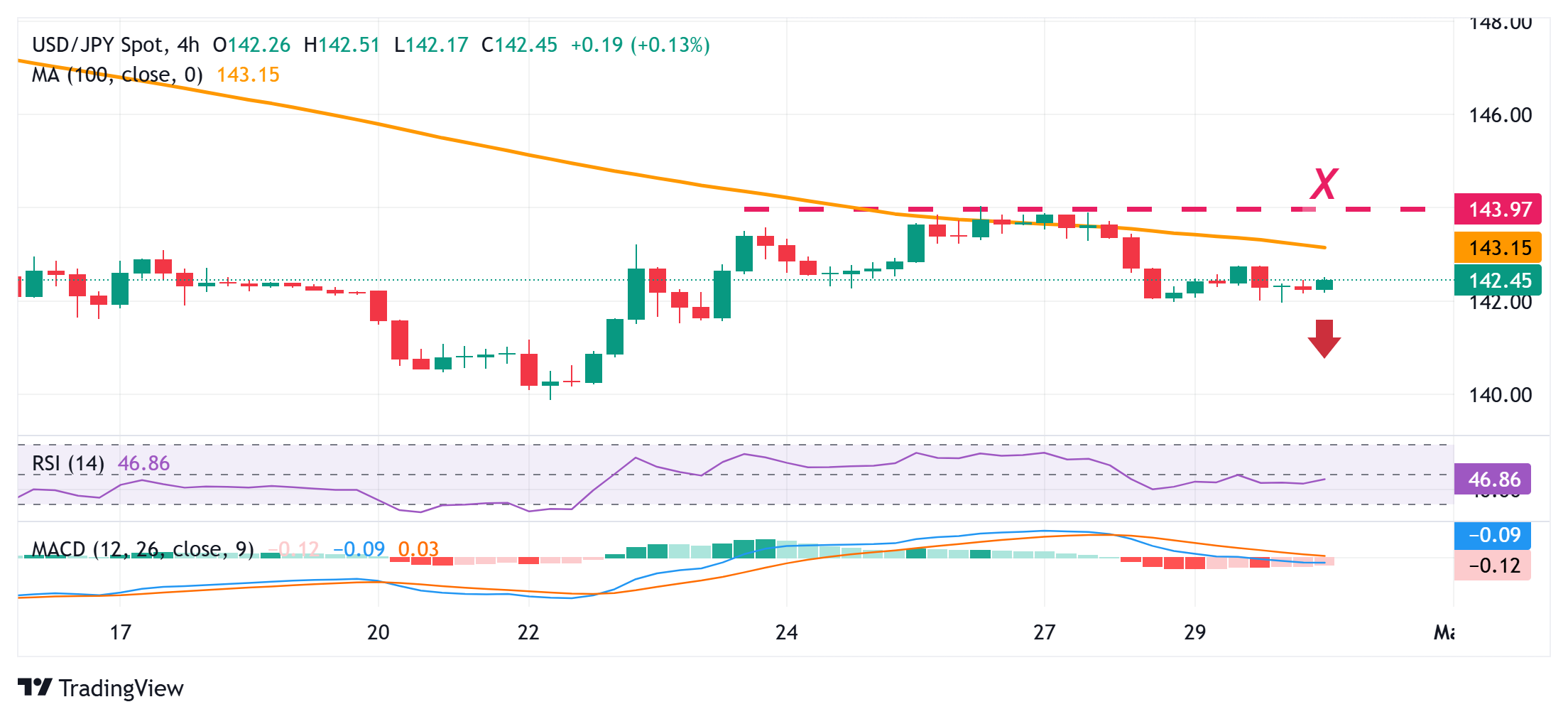
From a technical perspective, the USD/JPY pair earlier this week struggled to find acceptance above the 100-period Simple Moving Average (SMA) on the 4-hour chart and faced rejection near the 144.00 mark. The subsequent downfall and negative oscillators on hourly/daily charts validate the near-term negative outlook. That said, it will still be prudent to wait for some follow-through selling below the 142.00 mark before positioning for deeper losses. Spot prices might then accelerate the fall towards the mid-141.00s en route to the 141.10-141.00 region. The downward trajectory could extend further towards the 140.50 intermediate support before the pair eventually drops to the multi-month low – levels below the 140.00 psychological mark touched last week.
On the flip side, the 142.60-142.65 region is likely to act as an immediate hurdle, above which a bout of a short-covering could lift the USD/JPY pair beyond the 143.00 mark, towards the next relevant resistance near the 143.40-143.45 zone. A sustained strength beyond the latter should allow spot prices to conquer the 144.00 round figure. Acceptance above the latter would suggest that the currency pair has formed a near-term bottom and pave the way for some meaningful upside.
Economic Indicator
BoJ Interest Rate Decision
The Bank of Japan (BoJ) announces its interest rate decision after each of the Bank’s eight scheduled annual meetings. Generally, if the BoJ is hawkish about the inflationary outlook of the economy and raises interest rates it is bullish for the Japanese Yen (JPY). Likewise, if the BoJ has a dovish view on the Japanese economy and keeps interest rates unchanged, or cuts them, it is usually bearish for JPY.
Read more.Next release: Thu May 01, 2025 03:00
Frequency: Irregular
Consensus: 0.5%
Previous: 0.5%
Source: Bank of Japan
Forex News
Keep up with the financial markets, know what's happening and what is affecting the markets with our latest market updates. Analyze market movers, trends and build your trading strategies accordingly.
